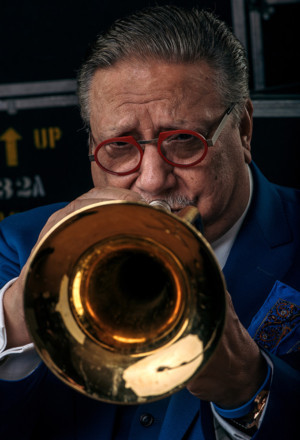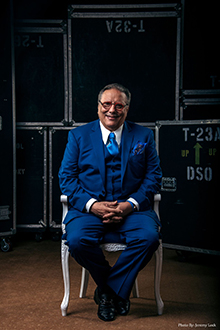Review: THE SAN DIEGO SYMPHONY PRESENTS THE ARTURO SANDOVAL SEXTET at the Bayside Amphitheater

Arturo Sandoval is best known as a Latin trumpeter. But at their San Diego Bayside Jazz performance, his sextet displayed exceptional versatility. At tempos from ballad-slow to escape velocity, they rocked the waterfront with Latin, bop, funk and even a little metal rock. Sandoval, in addition to trumpet, played flugelhorn, keyboards, and timbales, with a few vocals and a lot of clowning around thrown in.
The sextet included Michael Tucker, tenor saxophone, Tiki Pasillas, Latin percussion, Max Haymer, piano, John Belzaguy, bass and Johnny Friday, drums, all first-rate musicians. The leader switched between Latin and straight-ahead jazz. The saxophonist was more often in jazz's mainstream. After Sandoval, he had the most solo space, and excelled in a swinging blues groove and during a beautifully melodic solo on "When I fall in Love."
The first of two sets began with an up-tempo "Bb Blues" and segued without a break into "Funk Jam." Bb Blues featured typically high trumpet work, virtuosic runs and scat singing from Sandoval, the scatting reminiscent of Clark Terry's hilarious work on Mumbles, a recording that great trumpeter made half a century ago. The second tune segued to a funky pop-mood with the leader on Moog synthesizer for fuzz guitar effects before he switched to trumpet to take it out.
What followed was a roughly seven-minute monolog ramble by Sandoval, friendly and relaxed, but longer than it needed to be. Among other things, the audience learned that he ODs on espresso (no drugs or alcohol) and thinks the best cigars now come from Honduras rather than Cuba.
and relaxed, but longer than it needed to be. Among other things, the audience learned that he ODs on espresso (no drugs or alcohol) and thinks the best cigars now come from Honduras rather than Cuba.
Any impatience I felt during the digression quickly disappeared as "Lion for Lyons," an old Gerry Mulligan tune, began with a soft tasty duet between sax and trumpet. The arrangement and solos were jazz at its confident, relaxed best.
"Seven Steps To Heaven" finished the first set in a frenetic romp with infectious Latin percussion. The mood continued after the break as the second set began with "The Peanut Vendor," a Cuban tune first recorded in the 1920s, and so often recorded since that it's in the Grammy Latin Hall of Fame. A standard vehicle for Sandoval, it's a showcase for his extraordinary range on the trumpet, from tuba-like pedal tones to tones disappearing into frequencies only dogs can hear.
When Sandoval came down the steps into the audience to slow the pace, he graciously acknowledged the presence at the concert of saxophonist James Moody's widow, signed an autograph or two, and accepted the gift of a cigar which, to his great satisfaction, turned out to be Honduran! Having built some close-up rapport, he explained that, while he didn't have much of a voice, he was going to do a ballad he loved.
After a quiet instrumental intro, Sandoval sang "When I fall in love," proving he didn't have a great voice. But by then, the audience was in his pocket and willing to accept feeling and obvious love of the tune as a substitute.
Other tunes in the second set included two of Sandoval's own. "Soca Beat" returned the vibe to light-hearted Latin, this time Jamaican rather than Cuban, with the leader using the Moog's Caribbean steel-drum setting to reinforce a Calypso-related Soca rhythm.
Surenã, the second of Sandoval's tunes, was introduced as a vehicle for percussionist Pasillas, but the spotlight was on the leader's florid, near-classical piano technique for a long stretch before moving to Pasillas for the last few minutes.
The concert closed with a swinging version of Dizzy Gillespie's classic tune, "Night In Tunisia." Sandoval is probably the best-known of Dizzy's proteges, and the arrangement's mix of jazz and Latin styles brought out the sextet's most entertaining and satisfying best, sending the crowd home with appreciative smiles.
At 69, with over a half century of performing and a trunk full of awards as musician and composer, Sandoval can, understandably, sound a bit cranky when referred to as a "Latin trumpeter." With an almost child-like drive to entertain and amaze, he goes out of his way to show his talent is indeed much broader than that. Though a bit of a showboat at times, he is a terrific and versatile musician who works his tail off on stage with infectious energy and skill. His sextet is a treat to see and hear.
 The San Diego Symphony's jazz curator Gilbert Castellanos was, like Sandoval, encouraged and helped in his early career by Dizzy Gillespie. This coming week Castellanos brings a third Gillespie protégé, Jon Fadis, to the Bayside Jazz series in a tribute to "The Godfathers of Latin Jazz." For information about that and other scheduled concerts in the series visit here.
The San Diego Symphony's jazz curator Gilbert Castellanos was, like Sandoval, encouraged and helped in his early career by Dizzy Gillespie. This coming week Castellanos brings a third Gillespie protégé, Jon Fadis, to the Bayside Jazz series in a tribute to "The Godfathers of Latin Jazz." For information about that and other scheduled concerts in the series visit here.
Photos courtesy San Diego Symphony.
Add Your Comment
Videos
